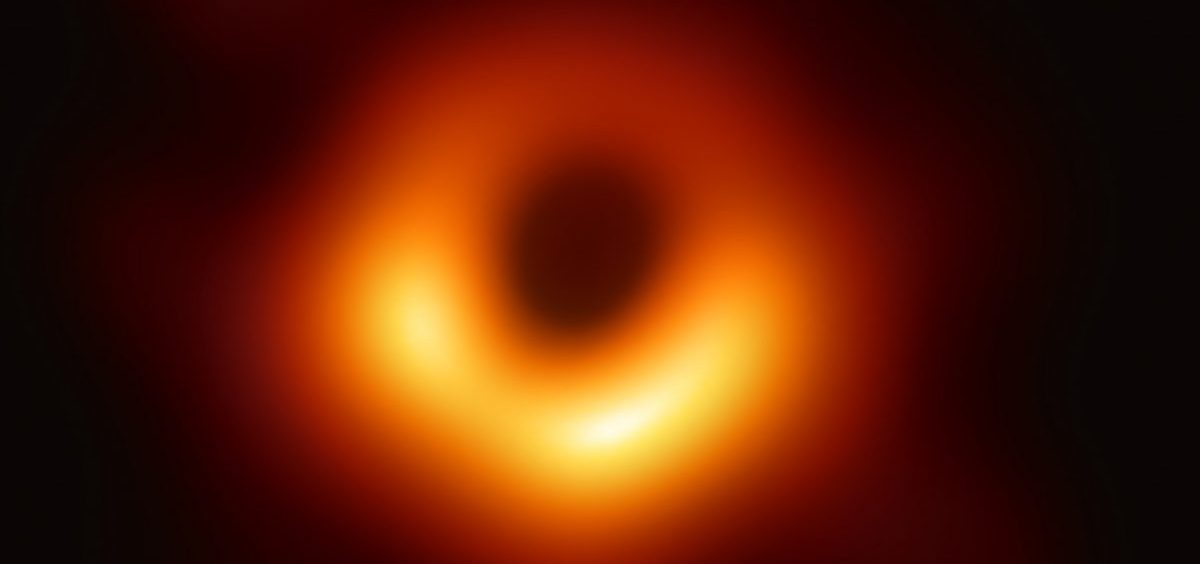News

A Black Hole Is Photographed For First Time By Massive Telescope Project
By: Bill Chappell | NPR
Posted on:
The world is seeing the first-ever image of a black hole Wednesday, as an international team of researchers from the Event Horizon Telescope project released their look at the massive black hole at the center of galaxy Messier 87 (M87). The image shows a dark disc “outlined by emission from hot gas swirling around it under the influence of strong gravity near its event horizon,” the consortium said.
“As an astrophysicist, this is a thrilling day for me,” said National Science Foundation Director France A. Córdova.
The enormous black hole is some 55 million light-years from Earth in the Virgo galaxy cluster, with a mass some 6.5 billion times that of our sun.
“I am delighted to report that we have, for the first time we have seen what we thought was unseeable. We have taken the first picture of a black hole,” said EHT Director Shep Doeleman of Harvard University.
Córdova and Doeleman led a news conference in Washington, D.C., to discuss the team’s finding — a process that took place simultaneously on four continents, as researchers held press conferences to share news of what they’re calling “a groundbreaking result.”
“You have probably seen many, many images of black holes before,” said Heino Falcke, a principal investigator on BlackHoleCam. “But they were all simulations or animations. And this [image] is precious to all of us, because this one is finally real.”
Pointing to the screen at the European Research Council’s news conference in Brussels, Falcke said that the much-sought-after image “looks like a ring of fire. And it’s actually created by the force of gravity, by the deformation of space-time, where light actually goes around the black hole, almost in a circle.”
The black hole is some 100 billion kilometers across. But despite its massive size, anyone trying to find it in the night sky from the Earth’s surface would face the same challenge if they stood in Brussels and wanted to see a mustard seed in Washington, Falcke said.
It’s well-known that a black hole’s gravity is so overpowering that even light cannot escape its center. But black holes also dramatically affect their surrounding space, most obviously by creating an accretion disk — the swirl of gas and material that rapidly orbits their singularities.
“Black holes are the X-games of physics. They represent an unexplored extreme of space-time,” as astrophysicist Adam Frank wrote for NPR in 2017. “While we now have good indirect evidence that they exist, getting a direct view of a black hole is the ultimate dream for a lot of physicists.”
A breakthrough in black hole detection promises to answer a question that has dogged scientists since Albert Einstein proposed the existence of black holes in his general theory of relativity: How do you document the presence of something that’s invisible?
Researchers at the Event Horizon Telescope project say they were able to create an image of a black hole by using a network of eight radio telescopes to create “a virtual telescope dish as large as the Earth itself,” the National Science Foundation says.
That array of telescopes is in places from Antarctica to Arizona. Before scientists can analyze data from the network, a painstaking process must take place. Each signal received by the telescopes must be synchronized wave by wave, using atomic clocks and a supercomputer to correlate and combine observations from around the world.
In a few weeks of observing the black hole, the EHT project amassed 5 petabytes of data, which Dan Marrone of the University of Arizona said was equivalent to “all of the selfies that 40K people will take in their lifetime.”
To find a black hole massive enough to potentially be visible from an Earth-sized telescope, the Event Horizon researchers focused on “supermassive” black holes that are found at the centers of galaxies.
They focused on the black hole at the center of galaxy M87 because of its gargantuan size and other characteristics.
“M87 is the nearest galaxy with a supermassive black hole that’s generating a powerful jet — a beautiful streamer made of plasma travelling at close to the speed of light,” said Charles Gammie, a professor at the University of Illinois at Urbana-Champaign who is on the EHT Science Council Board.
In a news release about the breakthrough, Gammie said: “One of the great mysteries in astronomy has been how such jets are launched. Our simulations, which are based on the motion of magnetic fields and hot gas near the black hole, showed that the jets are powered by the black hole itself. Magnetic fields act to brake the rotation of the black hole and transfer its rotational energy to the jet.”
As they analyzed the image and related data, astronomers also grew increasingly confident with other assumptions they’ve made based on theories about the workings of the universe.
“Once we were sure we had imaged the shadow, we could compare our observations to extensive computer models that include the physics of warped space, superheated matter and strong magnetic fields. Many of the features of the observed image match our theoretical understanding surprisingly well,” said Paul T.P. Ho, EHT board member and director of the East Asian Observatory. “This makes us confident about the interpretation of our observations, including our estimation of the black hole’s mass.”
9(MDI4ODU1ODA1MDE0ODA3MTMyMDY2MTJiNQ000))

